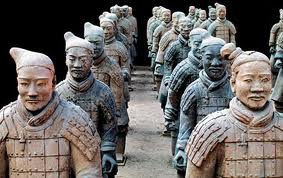 We all have heard about the mystifying archaeological discovery that happened in 1974 when a group of farmers attempting to a dig a well near the ancient capital city of Chang’an in what is today the Shaanxi Province, near the modern city of Xi’an, China, incredibly found instead what is now known as the tomb of the Terra Cotta Army in a vast underground city.
We all have heard about the mystifying archaeological discovery that happened in 1974 when a group of farmers attempting to a dig a well near the ancient capital city of Chang’an in what is today the Shaanxi Province, near the modern city of Xi’an, China, incredibly found instead what is now known as the tomb of the Terra Cotta Army in a vast underground city.
The “army” is made up of around 7,000 lifelike clay soldiers and included clay replicas of horses, chariots, bowmen, archers and all their attendant armor and weaponry that were said to be created in 246 B.C. by China’s first emperor, Qin Shi Huang, to protect him in his journey after death.
According to historical records, the emperor had an army of one million professional soldiers built, and was the one who initiated construction of the Great Wall of China.
Arranged in battle formation in pits near the emperor’s tomb, the clay army stood watch for more than 2,000 years, until the discovery in 1974.
Since then, archaeologists have puzzled over how ancient artisans produced the estimated 7,000 lifelike clay soldiers, right down to their stylish goatees and plaits of braided hair.
But, not anymore, and only because of the difference in the shape of the “soldiers” left ears.
Slowly, archaeologists have learned the secrets of the amazing clay statues, including how they were painted, but were still puzzled by how their realistic features were created. Now, after creating 3D models of the warriors using new imaging technology, the archaeologists from the University College London and Emperor Qin Shi Huang’s Mausoleum Site Museum have found the statues were perhaps modeled after real soldiers rather than given standard-issue noses, ears, and mouths “via a sort of Mr. Potato Head strategy,” explains archaeologist Andrew Brevan.
Their ears offered up the greatest clue: Ears vary so much among humans that they’re “as effective as a fingerprint” in terms of identification, he says.
(For more on this interesting solution to the puzzle about why the different looks of the terra cotta warriors, please go to this link: http://news.nationalgeographic.com/news/2014/11/141114-terra-cotta-warriors-qin-shi-huang-tomb-china-archaeology/)